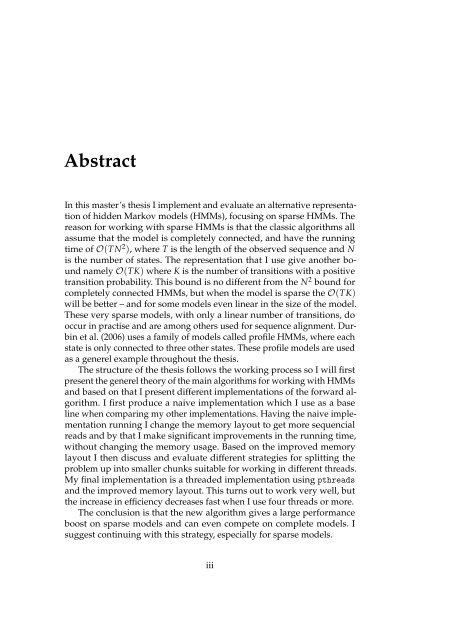MADS BAGGESEN - 20042326
MADS BAGGESEN - 20042326
MADS BAGGESEN - 20042326
You also want an ePaper? Increase the reach of your titles
YUMPU automatically turns print PDFs into web optimized ePapers that Google loves.
Abstract<br />
In this master’s thesis I implement and evaluate an alternative representation<br />
of hidden Markov models (HMMs), focusing on sparse HMMs. The<br />
reason for working with sparse HMMs is that the classic algorithms all<br />
assume that the model is completely connected, and have the running<br />
time of O(TN 2 ), where T is the length of the observed sequence and N<br />
is the number of states. The representation that I use give another bound<br />
namely O(TK) where K is the number of transitions with a positive<br />
transition probability. This bound is no different from the N 2 bound for<br />
completely connected HMMs, but when the model is sparse the O(TK)<br />
will be better – and for some models even linear in the size of the model.<br />
These very sparse models, with only a linear number of transitions, do<br />
occur in practise and are among others used for sequence alignment. Durbin<br />
et al. (2006) uses a family of models called profile HMMs, where each<br />
state is only connected to three other states. These profile models are used<br />
as a generel example throughout the thesis.<br />
The structure of the thesis follows the working process so I will first<br />
present the generel theory of the main algorithms for working with HMMs<br />
and based on that I present different implementations of the forward algorithm.<br />
I first produce a naive implementation which I use as a base<br />
line when comparing my other implementations. Having the naive implementation<br />
running I change the memory layout to get more sequencial<br />
reads and by that I make significant improvements in the running time,<br />
without changing the memory usage. Based on the improved memory<br />
layout I then discuss and evaluate different strategies for splitting the<br />
problem up into smaller chunks suitable for working in different threads.<br />
My final implementation is a threaded implementation using pthreads<br />
and the improved memory layout. This turns out to work very well, but<br />
the increase in efficiency decreases fast when I use four threads or more.<br />
The conclusion is that the new algorithm gives a large performance<br />
boost on sparse models and can even compete on complete models. I<br />
suggest continuing with this strategy, especially for sparse models.<br />
iii
















